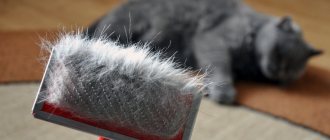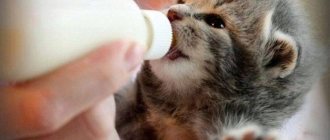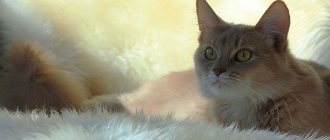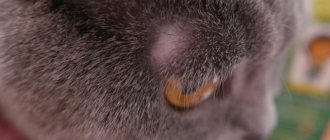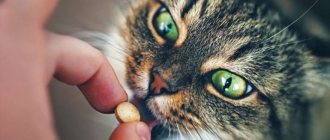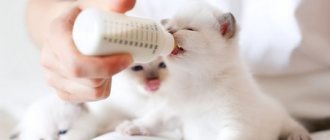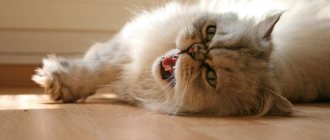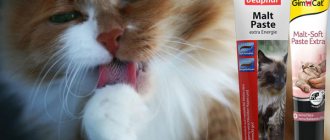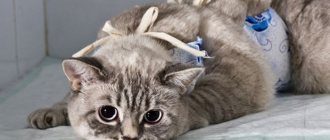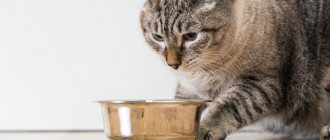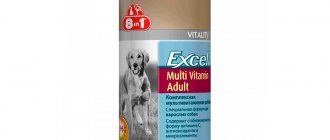Shedding in kittens
At what age do kittens start shedding? Do they need to be combed out? Is shedding as big a problem as everyone says it is? About this and much more in our article.
Little kittens practically do not shed, since instead of fur they have baby soft fluff. However, caring for a kitten's coat, and brushing in particular, must begin from an early age. And there are a number of reasons for this:
- It is much easier to train a small kitten to be groomed than an adult cat. Kittens love affection and love contact with their owner, so careful brushing will be a pleasant pastime for them. Thus, even as an adult, your pet will have a positive attitude towards combing, and grooming will not turn into a life-or-death struggle for him.
- Brushing kittens from an early age helps prepare them for their first molt. The first molting of kittens is the most intense and long-lasting, because the babies have to exchange baby fluff for adult, coarser fur. And the task of every responsible owner is to help the pet in this difficult task (and also protect their things from fur). During the molting period, the kitten must be combed thoroughly and regularly. This way you will contribute to the renewal of the coat and reduce the number of hairs remaining on your things. A kitten already familiar with brushing will endure the first moult much easier and calmer than its less experienced brother.
When does kittens start shedding? – It depends on the season, breed and individual characteristics of the pet, but the average age for the first moult is 5-8 months. Renewing your kitten's fur will require additional nutrients: vitamins, amino and omega-3 fatty acids. Start giving your baby a complex with fish oil and brewer's yeast (for example, Excel Brewer's Yeast) from the first days of shedding, and you will see that the new coat will grow healthy and beautiful, and the first shedding will go much faster.
- Brushing is a necessary procedure for furry pets, otherwise their beautiful fur will begin to gather in tangles.
- Brushing is not only grooming, but also a kind of massage that improves blood circulation, which is very useful for kittens.
Brushing, like other pleasant joint activities, helps to tune in to a wave of mutual understanding and trust, which is very important in building a relationship between an owner and his four-legged friend.
How to brush a kitten?
It is very important that the combing procedure itself is carried out gently and carefully. Do not scare the kitten with sudden movements, do not forget to praise him and talk to him. The baby should perceive combing as affection and reverent self-care; his associations with grooming should be extremely pleasant.
The most effective assistants in training to groom are treats and voice intonation. Give your pet a treat while brushing and after it’s finished, and encourage him. By tasting goodies and hearing the gentle voice of the owner while grooming, the baby will associate grooming with something infinitely pleasant, which means our goal has been achieved!
To brush small kittens, it is enough to use special soft tools that will not injure the hair and skin (for example, the FURminator first grooming kit, which includes a soft slicker brush and a wide-tooth comb). Our goal in this case is not to remove dead undercoat (since it is not there yet), but to accustom the baby to the procedure itself.
In adolescence, after the first shedding, it is best to use the FURminator anti-shedding tool to remove dead undercoat. Why him?
To date, this is the most effective remedy for combating molting. The tool reduces the amount of lost hair by up to 90%, which is beyond the capabilities of analogues. Thanks to these results, FURminator gained enormous popularity, which provoked the mass production of counterfeits. Therefore, before purchasing an instrument, be sure to check its authenticity.
Thanks to high-quality hair care, pet shedding ceases to be a problem. See this in practice!
Make your pets happy, and let them make you happy in return!
Raising the British
Raising British kittens should begin immediately upon the pet's arrival at home. If you waste time and do not accustom him to the litter box and routine, the cat will do everything his own way. As a result, cats can fully demonstrate their independent character, and the retraining process is very complicated.
- The British captivate with their aristocracy and self-esteem. Graceful British kittens are a breed that should not be subjected to force during the training process. In order not to humiliate their feline pride, do not hit them in case of a mistake, just poking them with your nose and a stern voice is enough. You can splash water on the mischief maker or clap your hands loudly in front of him. You will not achieve a favorable result by spanking a small cat, and he may become very frightened of your hand and begin to take revenge. Think about how to raise your baby before you take him in. Before and after a year, the behavior of British kittens can differ greatly. At first, they are very playful, inquisitive, and love to explore all the secluded places in a new place. Then they settle down and spend most of the time sleeping or walking around imposingly, watching what is happening in the house. To raise an affectionate one, the attitude towards your pet must be respectful, friendly, and moderately strict. In this case, it is not difficult to tame the baby, and he can become a devoted and loving friend. To prevent damage to your furniture, you need to train your cat to sharpen its claws in one place where the scratching post is installed. At the moment when the cat sharpens its claws in the wrong place, the owners need to say “no” every time in a stern voice and show where to do it correctly.
When do kittens start moulting?
Cats start shedding early. At about the age of six months, kittens begin to gradually change not only the structure, but the color of their fur. The duration of the first moult varies. Sometimes at least 6 months. During this time, the kitten sheds baby fluff, growing dense guard hairs. In point and multi-colored cats, the markings appear brighter. The appearance becomes complete.
You need to combat molting in a comprehensive manner. To begin with, support the kittens with vitamins and enhanced nutrition. In addition, this is a good opportunity to accustom your pet to hygiene procedures: combing and bathing. And simply smoothing your fur coat with a damp hand will not only be pleasant, but also useful.
Don't miss this moment: how well you take care of your kitten will determine the appearance of an adult cat in the future.
Breed
Burmese cat, character of kittens and Burmese cats
Sometimes kitten owners get a real shock when their hairless kitten suddenly starts to become covered with hair. But sometimes this also happens - a special mutation is used that turns a purebred hairless cat into an alien with separate tufts of hair growing, most often on the sides or behind the ears. Some kittens lose their fur as they age and become completely bald, while some remain fluffy.
Why and how cats shed
Subsequently, molting will become regular. For cats, this is a natural process of preparing for the change of season. Ideally, a cat sheds twice a year:
- before the cold weather begins. Reducing daylight hours and a significant decrease in temperatures include protective mechanisms that involve a change in wardrobe. Cats are rapidly growing a new coat that can protect them from frost. For example, the British grow a powerful, dense undercoat, which is much thicker than the summer one;
- before the onset of heat. Rising temperatures make it necessary to prepare for the summer heat. “Winter” fur, having served its purpose, is no longer needed. Therefore, a lightweight version is growing.
Cats that have free range react most strongly to the change of seasons. Their bodies are exposed to natural weather conditions and are sensitive to the changing seasons.
Cats living in an apartment without walking, despite the lack of seasonality in the home climate, also shed. Only the time of this process is not strictly tied to the environment. Depending on the breed, cats shed 1-2 times a year.
It should be borne in mind that in mature, uncastrated cats, shedding can begin at any time as a reaction to certain changes in physiology. This is how the body will react to hormonal changes during estrus or after kittens are weaned from mother's milk. This is not a reason to panic, you just need to provide your cat with improved nutrition and vitamins.
White and color point kittens
These cats have a distinctive feature - blue, green or copper eyes. At the same time, the color coding indicates the feature. White kittens are often born with small markings. Their color is dull and their sizes are minimal.
Just like with black solids, they disappear as they grow older. White kittens of the British breed cannot have a warm shade, only a pure and bright color.
Important: White color is distinguished from cream by the color of the nose. The latter have a warm shade. Cream is a derivative of red color in a lightened version.
Color point kittens have markings on the face, tail, paws, and darkened fur on the back. The main background is light. The unusual color was inherited from exotic breeds. The markings may have a tabby pattern. The background colors are black, purple, cream, red and chocolate.
How long does seasonal molting last?
If you are scared by your kitten's long first molt, don't worry. This is due to complex processes of physiological maturation. Shedding in cats that can be called adults goes back to normal. On average it lasts a couple of months a year. Once in the spring, and again at the end of autumn. There may be minor time shifts in the schedule.
Usually short-haired pets fit into the schedule and timing of shedding. It’s more difficult with the fluffier ones. Persians or Maine Coons, after shedding their guard hairs, take a long time to get rid of the undercoat. They definitely won't be able to do it without your help. If you don't help them with their struggle, the consequences can be serious. From local tangles to completely matted fur.
Sometimes shedding in cats occurs unplanned or does not stop for a long time.
Body type
Korat cat - description of cats and kittens of this breed
Almost all kittens, unless, of course, they are the owners of super fluffy fur, are skinny, long, funny creatures. But with age they turn into so many things. Some become an elegant, muscular cat, reminiscent of their wild ancestors, panthers and cheetahs, while others become...a shapeless, but terribly cute ball, preferring to lie in the sun or lazily stretch. This sign, unlike the previous two, completely depends on living conditions and maintenance and can be controlled by a person.
Reasons for intense year-round shedding
Considering that shedding in cats is a natural physiological process, it is important to understand when it goes beyond the normal. If fur falls out intensively for more than a month, especially out of season, and without objective prerequisites, this is a reason to think about the reasons for what is happening.
Usually a cat sheds a lot:
- During illness. It doesn't matter if there is an internal disease or the cause is on the surface of the body, shedding in cats is an indicator of health. In normal condition, fluff does not fly in different directions. Moreover, you can suspect anything: from banal vitamin deficiency or allergies to serious diseases of internal organs. Only specialists will carry out competent diagnostics. You should not self-medicate, as you will only make the problems worse.
- Unsuitable care products. If health is not suspicious: tests are normal, behavior is active, and shedding does not stop, this is a reason to change the shampoo, at a minimum. Ideally, change all cosmetics for the cat. You may be using the wrong brush. Pay attention to what accessories are recommended by breeders and veterinarians for each specific breed separately for everyday care and for the molting period.
- Errors in feeding. Often the reasons for year-round molting are in the food. Natural food must be prepared according to special recipes that provide an ideal balance of nutrients. Be sure to supplement with vitamin supplements a couple of times a year. Ready-made food, even the most expensive and high-quality, is also not a guarantee of peace of mind. One ingredient that is individually unacceptable to your cat and shedding is guaranteed all year round. Choose carefully. Preferably, with control through analysis.
- Stress. Among cats there are phlegmatic cats that hardly react to changes in the external environment. But there are cats for whom even your daily trips to work become the real end of the world. Jealousy, lack of attention, loud noises, unfamiliar smells - this world is fraught with many dangers and possible causes for stress for cats. If diseases are excluded, feeding and accessories are checked to the smallest detail, go to the veterinarian for a sedative.
Increased shedding
If a cat sheds a lot, then this is bad and it is necessary to immediately find out the reason for this condition of the animal.
Increased shedding may be due to several reasons:
- If your cat suddenly begins to shed and develops a skin rash, you should immediately contact your veterinarian. After all, your pet may have a serious dermatological disease.
- A cat may begin to go bald after extreme stress. This may happen due to the fact that the owner left him alone for a long time, or if a child was born in the family and all attention is paid to him. Cats are very susceptible to such things and have a hard time dealing with stress.
Pets are very gentle and affectionate creatures, so even the slightest stress can seriously affect the cat's body. To prevent your pet from thinking that they no longer love him, communicate with him, play and pay more attention.
Methods for reducing fur during shedding
When a cat sheds, you will need a whole arsenal of tools to fight it:
- Complete balanced nutrition.
- Supplements and vitamins. Particular emphasis on amino acids. Along with veterinary supplements, you can give an egg yolk and be sure to leave the sprouted grass. For long-haired dogs, it makes sense to buy a paste to remove lumps from the digestive system.
- Give the cat a bath. With water and subsequent combing, the lion's share of dead hairs is eliminated.
- Combing. Cats with short fur without a lot of undercoat will get by with a regular brush a couple of times a week. For furry cats or cats with thick undercoat, you may have to resort to a furminator.
Vitamins to strengthen the coat of cats during shedding
It is recommended to use an integrated approach when dealing with seasonal and non-seasonal shedding. Using a furminator, a balanced diet and taking vitamin supplements will improve the condition of your cat's coat, making it stronger and more beautiful. During shedding, a cat weakens, becomes lethargic, less mobile, and has metabolic disorders. During this period, the animal must be given fat supplements (especially in winter), brewer's yeast, B vitamins, and amino acids.
Currently, you can see a huge number of vitamins for cats (including anti-shedding vitamins) on sale.
Are there any non-shedding cat breeds?
The desire to have a cat with a flowing coat can be realized without the exhausting struggle with shedding if you have the opportunity to have a Burmese, American Curl, Somali or Turkish Angora.
Shorthaired Siamese, Abyssinians, Burmese, Bengals, Singaporeans, Egyptian Mau or Bombay cats will cause minimal problems.
There is a completely exotic solution to the shedding problem: rexes and sphinxes. These cats definitely do not shed in the traditional sense of the word.
Choose a cat with the prospect of spending at least 10 years side by side with her, and with a successful combination of circumstances, as many as 20. The shedding of Persians, Britons, Siberians or Maine Coons has made them not the most popular among lovers of order and cleanliness in the house. No amount of care or improved nutrition can prevent their marks from appearing in the most inappropriate places.
Scottish cat shedding: reasons and what to do?
The article was approved by felinologist Irina Kazak
There are many legends associated with wool about Scottish cats. Some even call them hypoallergenic, although this is not true. Some people think that if they buy a short-haired beauty, then there will be no problems with shedding at all. Is it so? Does a Scottish cat have hair that sheds? When do Scottish cats shed? Let's figure it out.
Do Scottish cats shed a lot?
Scottish cats shed. Moreover, the Scottish Fold cat sheds no less than the straight-eared one: this does not depend on the shape of the ears. The semi-long-haired varieties of the Scottish breed Highland Fold and Highland Straight are similar in the amount of shedding hair to Scottish Folds and Scottish Straights, only in Scottish cats the hairs are short and therefore fly around the apartment, and in Highlands they are longer and heavier, so they often hang on furniture and on clothes, but they don’t fly and don’t get in your face.
Baby shedding, or When Scottish kittens change their fur
Does your Scottish cat have a lot of fur the first time? Perhaps this is the so-called baby molt. When do Scottish kittens' coats change from baby to adult? The first molt occurs when cats are 5-6 months old, give or take. At this age, within 1-2 months, the Scottish cat's hair grows so much that it seems as if there will be no end to this problem.
The molting period of a Scottish kitten will end, but it can smoothly transition into a calmer phase, the duration of which sometimes reaches 1 year. During this period, the teenager must gradually change the primary, soft fur given to him from birth with adult, coarser, denser and more contrastingly colored fur. At the end of the child's molt, the coat becomes more beautiful, and the pattern required by the color appears in all its glory.
When do kittens change their fur to that of an adult?
Any woman strives to keep the house in good, well-groomed condition, monitors cleanliness and order. But heavy shedding of an animal can create a problem for a caring owner and cause concern about the health of the pet. If a cat sheds a lot, what should you do in this case? It’s not very pleasant when there are piles of wool left on carpets and furniture.
When is shedding a problem?
If the cat begins to shed heavily, then you should think about what measures should be taken. If you sort this issue out, then it will be possible to return the house to cleanliness and take care of the health of your pussy. To begin with, it is worth saying that the animal has a period when molting is natural. Every owner should know what time shedding occurs.
The fact that shedding has begun can be determined by tugging on the fur. If shreds of fur remain in your hands, this means that the molting period has begun. But it’s another matter when wool falls out all year round, in which case it’s worth taking other measures.
Seasonal shedding of Scottish cats
During seasonal molting, cats' fur and upper epidermis partially change. Seasonal molting is designed to adapt the animal to changing temperature conditions. Roughly speaking, by the summer cats shed excess fur, growing thinner ones for better heat transfer, and in the winter they gain a denser and thicker coat.
Seasonal molting of cats occurs in the spring, closer to the beginning of summer, and in the fall, with the approach of the first cold weather. It all depends on the latitude where you live: if summer comes earlier for you, then molting will take place earlier, if winter comes later, then molting will take place later. And vice versa.
In addition, pets that do not go outside at all may not feel changes in the weather - then seasonal shedding will be practically eliminated or, on the contrary, will be constantly present. That is, the answer to the question of when Scottish cats shed will always be. Although the animal reacts more not even to temperature, but to changes in daylight hours, that is, it recognizes the approach of summer or winter by the time of sunrise and sunset.
Causes of color changes in cats
There is a lot of evidence that diet greatly influences the color of a cat's coat. Provocative foods include all brightly colored vegetables: carrots, beets, pumpkin, and seaweed. An excess/deficiency of certain trace elements (iron, zinc, iodine) can not only provoke various painful conditions, but also give the coat an unusual shade. Cat breeders working with black and blue colors pay especially close attention to their pets’ diet.
The color can also be affected by purchased foods - they contain dyes (with the exception of the holistic class). If, a few months after changing the brand of food, the fur changes color, then with a high probability the composition of the new product can be blamed for this - if everything is in order with the animal’s well-being, of course.
Sun
If your cat's coat color changes soon after regular sunbathing or several trips to the country, then there is no need to worry: cat fur fades in the sun just like any other. Ultraviolet light is an aggressive factor: under its influence not only vitamin D is formed, but also the color pigment is destroyed. The pet may turn red, yellow and even green.
You might be interested in: Why doesn't a cat step on its hind paws?
Temperature
As mentioned above, the process of manifestation of coat color in a cat is complex and begins at the embryonic stage. The well-known point (Siamese) colors appear due to the presence of a mutation in the animal’s genome, which makes the process of color development dependent on temperature. The body is warmer, and almost no pigment is formed here. But on the cooler paws, ears, muzzle and tail (all of them are called points), the pigment appears normally.
A pet of this color can noticeably darken in winter and lighten in summer if it has free access to the street.
Seasonal molt
The coat consists of several types of hair: underfur, guard hair and outer hair. Some breeds have all three types, others some two or even one. Shedding, which gives an unkempt appearance, is typical for animals with a well-developed undercoat and the amount of “harvest” in the form of fluff does not depend on the length of the guard hairs.
In representatives of breeds with a small amount of underfur or without it at all: Turkish Angora, Balinese, Bengal, Burmese, Siamese, oriental wool is replaced constantly and little by little. And when an actively shedding pet loses most of its down (lighter compared to guard and outer hair), it seems that the cat’s color has changed.
Why does a Scottish cat shed a lot?
There are times when shedding is stronger than it should be, which threatens to deteriorate the quality of the cat’s coat and health, as well as torment for the owners, who will literally drown in the hair. The fact that shedding is excessive is indicated by the rapid deterioration of the coat and the formation of areas of baldness.
Before you begin to act, you need to find out the reason for the abnormally heavy shedding. To do this, you need to consult with a veterinarian, who may find some kind of disease in your pet.
The most common cause of severe shedding is poor nutrition, which lacks vitamins, microelements and fatty acids. To eliminate this problem, just read the information on how to properly balance the diet of a Scottish cat by including enough vitamins and Omega-3 and Omega-6 fatty acids in the diet.
However, it happens that the animal receives all the vitamins, acids and minerals, but they are simply not absorbed. Most often this occurs due to hormonal imbalance, which, in turn, can be caused by cysts or tumors, poor functioning of the thyroid gland or adrenal glands. In this case, a veterinarian should take care of the treatment.
Eyes
Many kittens, like human babies, are born with blue eyes. But with age, few cats can boast of such a feature. Of course, every owner dreams of owning some unusual animal, but almost no one gets this opportunity. For example, if a kitten is completely black, then the baby blue eye color will eventually turn into yellow or green with a 99.9% probability, since there are no completely black blue-eyed cats. As cats age, their eye color changes gradually. At first they turn from blue to pale blue or gray, and then take on their final shade. Typically, cats' eye color is fully established by 4 months of age. To know exactly what color a cat's eyes will be, you need to look at the eye color of its parents. Before the age of two years, cats may also experience changes in eye color, but very minor ones.
Other Causes of Hair Loss
If your pet suddenly begins to shed not in adolescence or on the eve of summer (winter), this means that he has other reasons for shedding his fur that need to be found out and corrected.
If a cat sheds its fur during pregnancy or lactation, this means that it lacks certain vitamins and minerals that need to be replenished with the help of vitamin complexes and food regulation.
A cat can also shed its fur as a result of parasitic or infectious skin lesions (for example, ringworm).
In addition, the animal may go bald due to stress caused by moving to a new home, the death of a family member, or the arrival of a new pet or child. There may be other reasons for worry.
The reason is the aforementioned lack of fatty acids, vitamins and minerals, which can provoke not only increased seasonal shedding, but also shedding of fur when it is not supposed to.
Perhaps your pet's hair loss is caused by allergies or leukemia.
In any case, the diagnosis must be made by a veterinarian, since your treatment can only cause harm.
